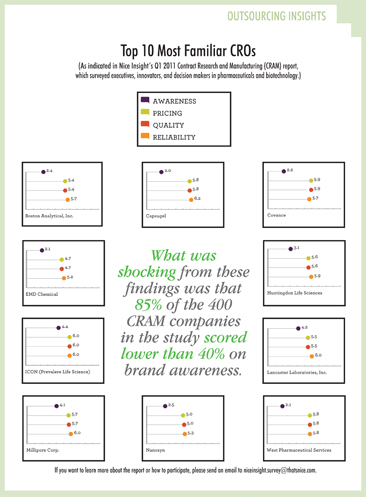Outsourcing Insights May 2011
By Victor Coker, director of business intelligence, Nice Insight
If you have been in the pharmaceutical industry for an extended period of time, you’ve likely noticed how CROs have evolved from offering basic support to providing a wide range of clinical, central laboratory, and analytical services to meet market demands. Currently, the trend is for smaller CROs (as defined by revenue market share) to consolidate. Coupled with acquisitions, the organizations relied upon for independent development services are expanding and adding new services. As a result, the market is flooded with CROs that perform the same early-stage services, making it difficult for pharmaceutical and biotechnology companies to find the ideal candidates for their particular projects.
Many management teams within these CROs have played into the traditional method of selection and simply focused on pricing structure as their primary means of attracting business. Cost is certainly a high priority when selecting the right CRO, particularly amidst the current constrictive economic conditions, but what happens if price is no longer a differentiator?
To investigate the efficacy of selecting a CRO partner based on price, Nice Insight reviewed the brand index data from our recently released Contract Research and Manufacturing (CRAM) report. First, we identified the top ten CROs of which our survey respondents (executives, innovators, and decision makers in pharmaceuticals and biotechnology) were most familiar — meaning respondents indicated they knew the companies well and/or had worked with them in the past. The results, in no particular order, were as follows: ICON (Prevalere Life Science), Lancaster Laboratories, Inc., Millipore Corp., Huntingdon Life Sciences, Nanosyn, Boston Analytical, Inc., Covance, EMD Chemicals (EMD & Millipore merged), West Pharmaceutical Services, and Capsugel.
It’s More Than Just Cost Structure
As suspected, we found the top 10 companies rated very similarly on the perception of pricing; however, this similarity was not reflected in brand awareness scores. For example, Lancaster Laboratories and Capsugel aligned closely in pricing, rating 5.5 and 5.8 out of 10, respectively. However, in terms of awareness, 42% of respondents indicated they were familiar with Lancaster Laboratories, whereas only 20% indicated the same of Capsugel.
So, while pricing is a factor, cost structure alone is not a clear indicator of the best-matched CRO for a project. The results of the Nice Insight Pharmaceutical and Biotechnology Survey revealed that pricing actually rated fourth out of the six main attributes considered by decision makers when selecting outsourcing partners. The attributes, in ranked order of importance were: quality, reliability, regulatory compliance, pricing, productivity, and accessibility.
No Single Factor = Success
After taking a deeper look into the results regarding how these attributes relate to partnering opportunities, it was clear that no single factor had the ability to drive success; rather, communicating differentiated value to the appropriate target audience in order to gain awareness was key. What was shocking from these findings was that 85% of the 400 CRAM companies in the study scored lower than 40% on brand awareness. Meaning, the vast majority of survey respondents did not even recognize the company names or logos.
Low awareness magnifies the difficulty of finding the right partner on both sides of the outsourcing relationship. As a CRO, it is impossible to receive business from companies who do not know you exist, regardless of your service offering or track record. As a pharmaceutical or biotechnology company seeking a new partner, the awareness gap may mean the CROs with the highest peer ratings are completely unknown to your organization. After all, the companies regarded as highly visible to some are completely unfamiliar to most.
To make the contracting selection process faster and more efficient, the Nice Insight CMO/CRO database has built-in filters that enable pharmaceutical and biotechnology users to search for partners within service sectors by region, market, and market sector. Once the companies are identified, the user can create a short list and rank companies according to their customer perception scores — which will further indicate whether attributes like quality and reliability were highly regarded by their previous partners.

